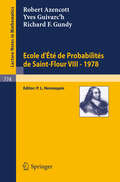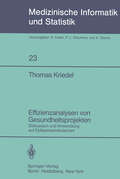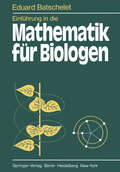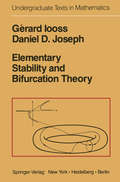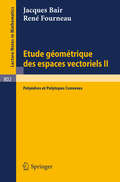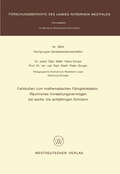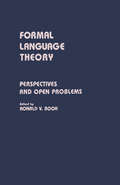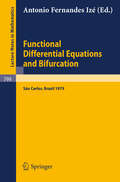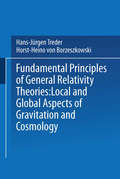- Table View
- List View
Ecole d'Ete de Probabilites de Saint-Flour VIII, 1978 (Lecture Notes in Mathematics #774)
by R. Azencott Y. Guivarc'h R. F. GundyEffizienzanalysen von Gesundheitsprojekten: Diskussion und Anwendung auf Epilepsieambulanzen (Medizinische Informatik, Biometrie und Epidemiologie #23)
by T. KriedelEinführung in BASIC (Programmieren von Mikrocomputern #1)
by Wolfgang SchneiderDie bevorzugte höhere Programmiersprache, die zum Dialog mit Mikro computern verwendet wird, ist BASIC. Der BASIC-Befehlsvorrat, auf den in diesem Buch eingegangen wird, wurde so ausgewählt, daß er sowohl in dem Normvorschlag für ein "Minimal BASIC" als auch in allen modernen BASIC-Versionen der Heimcomputer-Hersteller vorhanden ist. In den einzelnen Kapiteln dieses Buches wird der Leser in knapper, präziser Weise mit den elementaren BASIC-Regeln vertraut gemacht. Eine Vielzahl von Beispielen verdeutlichen die Regeln. Das Wichtigste wird einprägsam durch Merkregeln am Ende eines jeden Kapitels zusammengefaßt. Mit Hilfe von selbst zu lösenden Obungsaufgaben kann der Leser überprüfen, ob er die BASIC-Regeln beherrscht. Am Schluß des Buches zeigen 10 vollkommen programmierte und kommen tierte Beispiele, wie man das Wissen aus den einzelnen Kapiteln anwendet, um vollständige Programme zu schreiben. Dabei wird u.a. gezeigt, wie man eine Handelskalkulation aufstellt, eine Kurve einer mathematischen Funktion grafisch darstellt, eine Einkommen-bzw. Lohnsteuerberechnung vornimmt oder eine Computergrafik erstellt. Die Zusammenfassungen am Ende der einzelnen Kapitel erleichtern nach dem Erlernen von BASIC das Nachschlagen während der späteren selbstän digen Programmiertätigkeit. Wolfgang Schneider Cremlingen, Sommer 1979 VI Inhaltsverzeich n i s 1. Grundlagen der Datenverarbeitung ........................... . 1.1. Der Begriff der Datenverarbeitung .......................... . 1.2. Die Arbeitsweise einer Datenverarbeitungsanlage (OVA) ........... . 2. Programmiersprachen . . . . . . . . . . . . . . . . . . . . . . . . . . .. . . . 3 . . . . . . . 2.1. Allgemeines.. . . . . . . . . . . . . . . . . . . . . . . . . . .. . . . . .. . . . 3 . . . . 2.2. Maschinensprachen. . . . . . . . . . . . . . . . . . . . . . . . . . .. . . 3 . . . . . . . 2.3. Assemblersprachen .. . . . . . . . . . . . . . . . . . . . . . . . . .. . . 3 . . . . . . . 2.4. Problemorientierte Programmiersprachen ...................... 4 3. Heimcomputer .. . . . . . . . . . . . . . . . . . . . . . . . . . . . . .. . . . 5 . . . . . . . . 3.1 . Allgemeines...... . . . . . . . . . . . . . . . . . . . . . . . . . .. . . 5 . . . . . . . 3.2. Ausstattung von Heimcomputern. . . . . . . . . . . . . . . . . . . .. . . . 5 . . . .
Einführung in die kommutative Algebra und algebraische Geometrie (vieweg studium; Aufbaukurs Mathematik #46)
by Ernst KunzElementary Analysis: The Theory of Calculus (Undergraduate Texts in Mathematics)
by Kenneth A. RossDesigned for students having no previous experience with rigorous proofs, this text can be used immediately after standard calculus courses. It is highly recommended for anyone planning to study advanced analysis, as well as for future secondary school teachers. A limited number of concepts involving the real line and functions on the real line are studied, while many abstract ideas, such as metric spaces and ordered systems, are avoided completely. A thorough treatment of sequences of numbers is used as a basis for studying standard calculus topics, and optional sections invite students to study such topics as metric spaces and Riemann-Stieltjes integrals.
Elementary Stability and Bifurcation Theory (Undergraduate Texts in Mathematics)
by G. Iooss D. D. JosephIn its most general form bifurcation theory is a theory of equilibrium solutions of nonlinear equations. By equilibrium solutions we mean, for example, steady solutions, time-periodic solutions, and quasi-periodic solutions. The purpose of this book is to teach the theory of bifurcation of equilibrium solutions of evolution problems governed by nonlinear differential equations. We have written this book for the broaqest audience of potentially interested learners: engineers, biologists, chemists, physicists, mathematicians, econom ists, and others whose work involves understanding equilibrium solutions of nonlinear differential equations. To accomplish our aims, we have thought it necessary to make the analysis 1. general enough to apply to the huge variety of applications which arise in science and technology, and 2. simple enough so that it can be understood by persons whose mathe matical training does not extend beyond the classical methods of analysis which were popular in the 19th Century. Of course, it is not possible to achieve generality and simplicity in a perfect union but, in fact, the general theory is simpler than the detailed theory required for particular applications. The general theory abstracts from the detailed problems only the essential features and provides the student with the skeleton on which detailed structures of the applications must rest. It is generally believed that the mathematical theory of bifurcation requires some functional analysis and some of the methods of topology and dynamics.
Etude Geometrique des Espaces Vectoriels II: Polyedres et Polytopes Convexes (Lecture Notes in Mathematics #802)
by J. Bair R. FourneauEuclidean Harmonic Analysis: Proceedings of Seminars Held at the University of Maryland, 1979 (Lecture Notes in Mathematics #779)
by J. J. BenedettoEvolution and Variation of Multigene Families (Lecture Notes in Biomathematics #37)
by T. OhtaDuring the last decade and a half, studies of evolution and variation have been revolutionized by the introduction of the methods and concepts of molecular genetics. We can now construct reliable phylogenetic trees, even when fossil records are missing, by compara tive studies of protein or mRNA sequences. If, in addition, paleon tological information is available, we can estimate the rate at which genes are substituted in the species in the course of evolution. Through the application of electrophoretic methods, it has become possible to study intraspecific variation in molecular terms. We now know that an immense genetic variability exists in a sexually repro ducing species, and our human species is no exception. The mathematical theory of population genetics (particularly its stochastic aspects) in conjunction with these new developments led us to formulate the "neutral theory" of molecular evolution, pointing out that chance, in the form of random gene frequency drift, is playing a much more important role than previously supposed. I believe that the traditional paradigm of neo-Darwinism needs drastic revision. Also, the importance of gene duplication in evolution, as first glimpsed by early Drosophila workers, has now been demonstrated by directly probing into genetic material. Recently, it has been discovered that some genes exist in large-scale repetitive structures, and that they are accompanied by newly described phenomena such as "coincidental evolution". Working out the population genetical consequences of multigene families is a fascinating subject, for which Dr. Ohta has been largely responsible.
Explorative Datenanalyse: Frühjahrstagung der GMDS München, 21.–22. März 1980 (Medizinische Informatik, Biometrie und Epidemiologie #26)
by N. Victor W. Lehmacher W. van EimerenFallstudien zum mathematischen Fähigkeitsfaktor Räumliches Vorstellungsvermögen bei sechs- bis achtjährigen Schülern (Forschungsberichte des Landes Nordrhein-Westfalen)
by Hans KoopsA First Course in Group Theory (Universitext)
by Cyril F. GardinerOne of the difficulties in an introductory book is to communicate a sense of purpose. Only too easily to the beginner does the book become a sequence of definitions, concepts, and results which seem little more than curiousities leading nowhere in particular. In this book I have tried to overcome this problem by making my central aim the determination of all possible groups of orders 1 to 15, together with some study of their structure. By the time this aim is realised towards the end of the book, the reader should have acquired the basic ideas and methods of group theory. To make the book more useful to users of mathematics, in particular students of physics and chemistry, I have included some applications of permutation groups and a discussion of finite point groups. The latter are the simplest examples of groups of partic ular interest to scientists. They occur as symmetry groups of physical configurations such as molecules. Many ideas are discussed mainly in the exercises and the solutions at the end of the book. However, such ideas are used rarely in the body of the book. When they are, suitable references are given. Other exercises test and reinfol:'ce the text in the usual way. A final chapter gives some idea of the directions in which the interested reader may go after working through this book. References to help in this are listed after the outline solutions.
First Order Algebraic Differential Equations: A Differential Algebraic Approach (Lecture Notes in Mathematics #804)
by M. MatsudaFixed Rings of Finite Automorphism Groups of Associative Rings (Lecture Notes in Mathematics #818)
by S. MontgomeryFonctions de Plusieurs Variables Complexes IV: Séminaire François Norguet Octobre 1977 - Juin 1979 (Lecture Notes in Mathematics #807)
by François NorguetA Formal Background to Mathematics 2a: A Critical Approach to Elementary Analysis (Universitext)
by R. E. EdwardsFormal Language Theory: Perspectives and Open Problems
by Ronald V. BookFormal Language Theory: Perspectives and Open Problems focuses on the trends and major open problems on the formal language theory. The selection first ponders on the methods for specifying families of formal languages, open problems about regular languages, and generators of cones and cylinders. Discussions focus on cylinders of algebraic languages, cone of algebraic languages, regularity of noncounting classes, group complexity, specification formalism, and grammars. The publication then elaborates on very small families of algebraic nonrational languages and formal languages and their relation to automata. The book tackles morphisms on free monoids and language theory, homomorphisms, and survey of results and open problems in the mathematical theory of L systems. Topics include single finite substitutions iterated, single homomorphisms iterated, representation of language families, homomorphism equivalence on a language, and problems about infinite words. The selection is a valuable source of data for researchers interested in the formal language theory.
Function Theory in the Unit Ball of ℂn (Grundlehren der mathematischen Wissenschaften #241)
by W. RudinAround 1970, an abrupt change occurred in the study of holomorphic functions of several complex variables. Sheaves vanished into the back ground, and attention was focused on integral formulas and on the "hard analysis" problems that could be attacked with them: boundary behavior, complex-tangential phenomena, solutions of the J-problem with control over growth and smoothness, quantitative theorems about zero-varieties, and so on. The present book describes some of these developments in the simple setting of the unit ball of en. There are several reasons for choosing the ball for our principal stage. The ball is the prototype of two important classes of regions that have been studied in depth, namely the strictly pseudoconvex domains and the bounded symmetric ones. The presence of the second structure (i.e., the existence of a transitive group of automorphisms) makes it possible to develop the basic machinery with a minimum of fuss and bother. The principal ideas can be presented quite concretely and explicitly in the ball, and one can quickly arrive at specific theorems of obvious interest. Once one has seen these in this simple context, it should be much easier to learn the more complicated machinery (developed largely by Henkin and his co-workers) that extends them to arbitrary strictly pseudoconvex domains. In some parts of the book (for instance, in Chapters 14-16) it would, however, have been unnatural to confine our attention exclusively to the ball, and no significant simplifications would have resulted from such a restriction.
Functional Differential Equations and Bifurcation: Proceedings of a Conference, Held at Sao Carlos, Brazil, July 2-7, 1979 (Lecture Notes in Mathematics #799)
by Antonio F. IzeFundamental Aspects of Appropriate Technology: Proceedings of the International Workshop on Appropriate Technology Center for Appropriate Technology Delft University of Technology September 4—7, 1979
by International Workshop on Appropriate TechnologyBetween 4-7 September 1979, an international workshop on Appropriate Technology (AT) was organized in Delft, Netherlands, by the Center for Appropriate Technology of the Delft University of Technology. Representatives of 24 AT organisations from allover the world held discussions on the role of AT as a factor in development. There were two main objectives of the workshop - to enlarge the understanding of, and knowledge about the processes and conditions essential for the introduction of AT in regional deve lopment programs. This was formally referred to as 'the implementation of the results of AT research'. -secondly, an evaluation of the theories and models which have been applied for the establishment of these regional development programs. This was formally referred to as 'an inventory of AT concepts.' The workshop discussions focussed essentially on three issue areas: technology and development, organisational framework, and education and research. A summary of the conclusions and recommendatjons made by the workshop can be found in Chapter One of this report of the proceedings. All participants were invited, prior to the workshop, to outline their ideas on the subjects listed above, in position papers. Condensed versions of these papers are presented in Chapter Three.
Fundamental Principles of General Relativity Theories: Local and Global Aspects of Gravitation and Cosmology
by H. TrederThe present monograph is not a self-contained introductory text. Instead it presupposes to a large extent that the reader is not only thoroughly familiar with the special theory of relativity, but that he or she has studied the standard aspects of the general theory, as weIl. Starting from local and global formulations of the principlcs of inertia and relativity, we discuss the microscopic ancl telcscopic aspects of gravitation. Our central goal has been to demonstrate that the foundations of gravitational theory laid by Newton and Einstein imply questions on thc relation betwecn the micro- and macrocosm. The discussions surrounding these physical points can be rather weH understood without an elaborate mathcmatical formalism. All the same, we have attempted to make the main theme of our presentation accessible also to readers outside the circle of pundits by including two appendixes of a largely instructional nature. Appendix A gives a brief review of the basic concepts of four-dimensional spaces, for the convenience of readers who need 9 Preface such a recapitulation, while Appendix B deals with the more exotic notions of tetrad theory, which admittedly stands in wider need of elucidation. Both appendixes are meant in any event to serve the useful purpose of establishing our notation and collecting formulas for easy reference in the main body of the book. The general reader may accordingly find it helpful first to peruse one or both of the appendixes before turning to the Introduction and Chapter 1. H. -j.
Fundamentals of Numerical Computation: (Computer-Orientated Numerical Analysis) (Computing Supplementa #2)
by R. Albrecht U. Kulisch F. StummelFuzzy Sets and Systems: Theory and Applications (The\handbooks Of Fuzzy Sets Ser. #5)
by Didier J. DuboisFuzzy Sets and Systems
